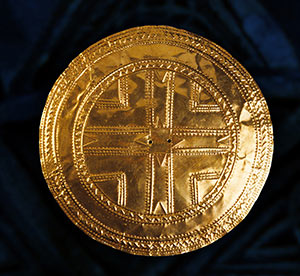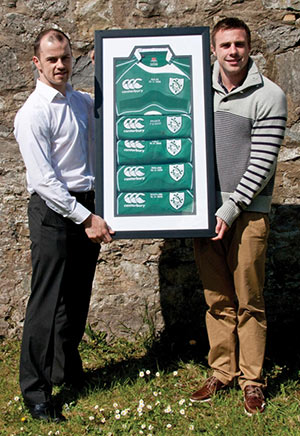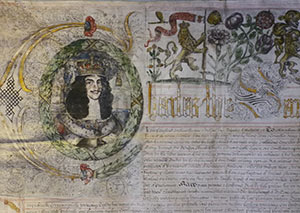MUSEUM EYE: Monaghan County Museum
Published in Issue 5 (September/October 2019), Reviews, Volume 271–2 Hill Street, Monaghan
By Tony Canavan

Above: One of the Tydavnet gold sundiscs, discovered by accident in the roots of an oak tree. (National Museum of Ireland)
Monaghan County Museum is located in a substantial nineteenth-century building in the heart of the town. The fabric of the building has been respected, meaning that the museum’s exhibits are divided over a number of rooms on different floors. Far from being a hindrance, this adds to the atmosphere, creating an air of anticipation as you wonder what you will find around the corner. The exhibits are placed in purpose-built display cabinets and the information panels are augmented by interactive video screens throughout the galleries.

Above: Former rugby international Tommy Bowe donating his jerseys from the 2009 Grand to museum curator Liam Bradley. (Monaghan County Museum)
The permanent exhibition covers the breadth of human experience in County Monaghan (and, by extension, Ireland) with nine themes, beginning with the First Settlers and taking the visitor through Early Christian Ireland, the Gaelic Chiefs, the Land and People, and so on right up to the twentieth century.
I was impressed not just by the quantity of artefacts on display—no space is wasted—but also by the quality. In the early section, look out for the Tydavnet gold sundiscs. These discs of beaten gold are decorated with an intricate design, indicating a level of sophistication in the community that produced them. Remarkably, they were discovered by accident in the roots of an oak tree. In an area dedicated to the Iron Age is the remarkable Altartate Cauldron. This large bowl was carved from one piece of wood, which is amazing in itself, but it also has moveable handles made of yew, a rarity.
As you move through the museum you will continually come across finds like this. For example, there is the intricately decorated Soisceal Molaise, a case made of metal to contain a copy of the Gospels. Not far from this is a cabinet dedicated to medieval life where you can see a well-preserved sword. Moving on through time, you will come across fine examples of uniforms, costumes and artefacts such as an eighteenth-century soup tureen, knuckledusters used for faction fighting, railway posters, and even a clay pipe with a pro-Sinn Féin slogan.

Above: The Cross of Clogher—on display in the Early Christian Ireland section. (Monaghan County Museum)
Perhaps bucking the modern trend, Monaghan County Museum is determined to tell a story. The nine themes are organised chronologically and take the visitor on a journey through the history of the county. Once you get into the historical period, key developments and events are explained via the objects on display. For example, ‘The New Order’ charts the defeat of the Gaelic chiefs in Ireland and the seventeenth-century Plantation of Ulster. Original maps illustrate how what became the modern county of Monaghan was divided among new settlers and towns were laid out where none had been before. There is a patent from Charles II to a certain Peter Beaghan, showing how this process continued into the seventeenth century, which leads on to the Penal Era of the eighteenth century and the consolidation of a new ruling class based on land and religion.

Above: Detail from a patent issued by King Charles II to one Peter Beaghan. (Monaghan County Musuem)
This history of the county, with one development following another, is continued throughout the museum right up to the recent past. Indeed, the section entitled ‘A Border Again’ seems very relevant just now with the prospects of a hard border being restored on the island. This section charts the local manifestations of episodes such as the Home Rule Crisis, the 1916 Rising, the War of Independence and the establishment of Northern Ireland.
Lest one get the wrong idea, the approach throughout is balanced and far from being boringly didactic. The material used to illustrate the narrative and the artefacts themselves all make this journey through history enjoyable. A visitor could easily spend an hour or more in the museum and not notice the time passing. All aspects of society are represented, with such objects as a militia uniform, a grand jury decanter, masonic regalia or a UVF armband sharing space with linen and lace, political posters, an IRA pistol and so on.
Towards the end of the permanent exhibition is the section on Arts and Crafts, which concentrates more on the social aspects of Monaghan’s history. Of importance is a cabinet of Carrickmacross lace, which was world-famous in its day. There is also an impressive collection of Belleek pottery, as well as more humble items such as smoothing irons, butterbats, a slane for cutting turf, a fiddle and so on. In an area dedicated to sport and pastimes there are cinema posters and even a collection of Ireland shirts worn by rugby star Tommy Bowe, a proud Monaghan native.
As well as its permanent collection, the museum has a gallery for temporary exhibitions. At the time of writing, the exhibition was about World War II (unfortunately it was closed to prepare for a function later that day). Monaghan County Museum is a lively place. Events for all ages and interests are held throughout the year; there is work with local schools and an outreach programme that brings the museum out to those who cannot, or perhaps would not, come to the museum. This is a good museum which makes the best use of the space available and fulfils its aim of relating Monaghan’s story from ancient times to the recent past.
Tony Canavan is editor of Books Ireland.
















